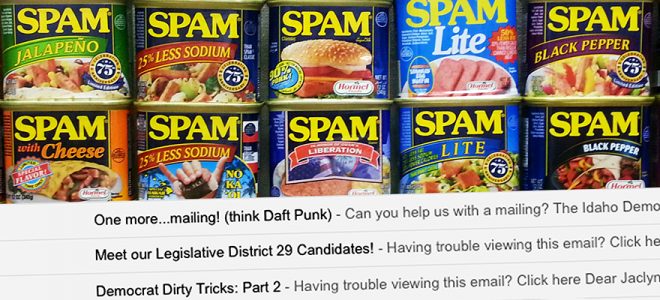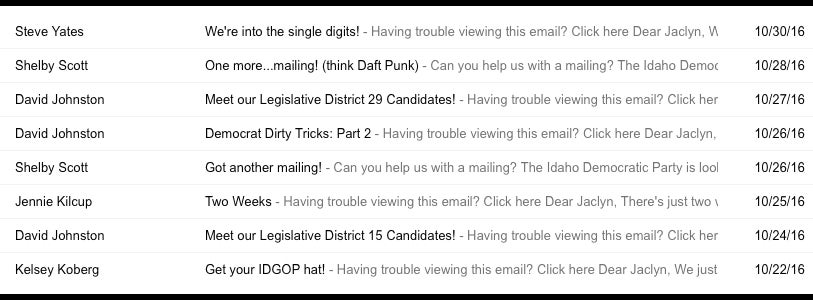

Jaclyn Kettler is assistant professor in political science at Boise State University. Her research focuses on American politics with an emphasis on state politics, political parties & interest groups, campaign finance, and women in politics. She earned her Ph.D. at Rice University and her BA at Baker University.
If you are like me, you may often ignore and delete marketing and campaign emails. While some people may view political emails as annoyances and spam, many people do open and read these emails. The open rate for political emails is about 22 percent for one major email marketing service. Although this is a small percentage, for campaigns with large email lists, this open rate may result in thousands of reads. This type of online messaging is now a major form of communication for political parties and campaigns, as email is a relatively cheap way to quickly communicate with a large number of people.
AN EFFECTIVE TOOL
In addition to being an effective tool for political parties, email offers valuable cultural and historical information, as it can help scholars and political observers analyze campaign strategies and tactics. Through political emails, we have access to a party or campaign’s direct communication with supporters and/or voters, including mobilization efforts and fundraising requests. For example, scholars have evaluated the impact of emails on voter registration and voter turnout. However, scholars rarely study party emails, so we do not yet fully know how parties utilize this form of communication. While there are a variety of possible research questions about party emails, I focus on two questions in this piece: Who sends the party emails? What are the purposes of the emails sent? By identifying who sends or signs emails for the party, we can evaluate key actors within the party and the goals of party emails. Identifying the sender of the email also allows us to examine whether the party shares its valuable email list with other party committees. Studying the purpose of party emails can help us better understand how a party uses email and their campaign strategies and tactics.
To address these questions, I collected Idaho Democratic Party (IDP) and the Idaho Republican Party (Idaho GOP) emails from July 15 through November 8, 2016 – otherwise known as Election Day. I am an unaffiliated voter and did not vote in either party’s 2016 primary or caucus. Parties sometimes vary their emails for different groups of recipients, so it is possible that the parties sent emails to their registered members (or other sub-groups) that were not collected in this study. At the very least, we can assume my sample includes emails sent to unaffiliated individuals subscribed to the Democratic and Republican state party committees’ email lists. During this period, I received 30 emails from two Idaho Democratic party committees – The Idaho Democratic Party and the Idaho Democratic Legislative Campaign Committee – and 39 emails from the Idaho GOP. While this is a limited sample, it covers most of the general election campaign period and provides some good insights into the parties’ activities and strategies during the 2016 election. Using some basic categorizations, I compared the signer, subject line, purpose and content of both parties’ emails. In this article, I discuss some of my findings regarding the source and purpose of the Idaho parties’ emails in the 2016 general election.
Signers and Sources of Party Emails: A key element of campaign emails is who the email is from, as the signer of an email may increase attention to the email or send an important message about the email’s contents. The ‘from’ field and the signature at the bottom usually indicates the signer of the email. Campaigns often draw upon a variety of actors to sign emails, including candidates and staffers. Examining email signers and sources can help us understand the party’s campaign strategies, activities and help identity other committees working with the party.
While both the Idaho Democratic and Republican parties sent some emails from the general party committee, most emails were from and included the signatures of party staffers or candidates. The Idaho Republican Party sent emails with five different signers and all were party staffers. David Johnston, the executive director of the Idaho Republican Party, signed 51 percent of the Idaho GOP’s emails (20 emails), making him the party’s most common signer.

The Democratic Party emails were slightly different in that the Idaho Democratic Party shared their mailing list with the Idaho Democratic Legislative Campaign Committee (IDLCC). The IDP sent emails mainly from the general party committee. An intern for the state party committee did sign an email requesting volunteers to help with the party database. The IDLCC, on the other hand, sent emails signed by eight different people, including state legislators and party staffers. Democratic state lawmakers founded the IDLCC, so it makes sense that state legislators are signing some of the committee’s emails. Shelby Scott, the legislative services director for the Idaho Democratic Legislative Campaign Committee, was the most common signer for the IDP and IDLCC with 53 percent of the Democrats’ emails coming from her (16 emails).
Both parties relied on staffers to sign their emails. However, there was a key difference between the two parties’ emails. Most of the Democratic emails I received are actually from the Idaho Democratic Legislative Campaign Committee. The signers of these emails are a party staffer or state legislator on behalf of the IDLCC, and the IDLCC paid for the emails. Since I only signed up for the Idaho Democratic Party’s email list, this suggests that the Idaho Democratic Party shared their email list with the IDLCC.
INTERCONNECTED NETWORKS
In the last several decades, the national political parties have become interconnected networks of party committees, interest groups and candidates. To help achieve mutual goals and elect candidates likely to promote the party’s agenda, the actors within these party networks share information, strategies and resources (including money and mailing lists). These networks ensure parties can provide candidates with campaign services and resources. Therefore, this type of cooperation between party committees is increasingly common as parties attempt to stay relevant in candidate-centered campaigns.
The Idaho GOP’s emails, on the other hand, are all from the state party committee during this period. While one email does advertise an Ada County Republican Party event, the Idaho Republican Party paid for all emails sent to their mailing list and the signers are staffers for the state party committee. There are some state-wide Republican party committees in Idaho similar to the IDLCC, such as the Senate Republican PAC. While some of these Republican committees share resources like money and may have shared email lists in the past, the Idaho Republican Party has not yet shared my email address with other Republican committees. This suggests that party committee cooperation through the sharing of email lists mainly occurred on the Democratic side in the 2016 Idaho general election.
PURPOSE OF PARTY EMAILS
The content of political parties’ emails can help us understand the campaign strategies and tactics adopted by the parties in the general election. For example, emails have become an effective way to fundraise. Donations through fundraising emails accounted for most of the $690 million that President Barack Obama raised online during his 2012 re-election campaign. National party committees and candidates have built large and valuable email lists through which to fundraise. Although social media use by parties and candidates is increasing, email continues to be a crucial digital platform for campaigns.
To analyze the content of party emails, I recorded the purpose of party emails using five categories: election, event, fundraising, general party business and get out of the vote (GOTV). I also cataloged sub-purposes of the email and any fundraising pitches included in the email.
The Idaho Democratic and Republican parties adopted slightly different approaches to their mass emails. Event and fundraising emails comprised the majority of emails for both parties. However, this was a slight majority of emails for the Idaho GOP and a large majority of emails for the Democratic party committees. Almost 80 percent of the IDP and IDLCC emails advertised a party/campaign event or was a fundraising request (23 emails), while 51 percent of the Idaho Republican Party’s emails were event or fundraising emails (20 emails). The Democratic party committees also sent several election and general party business emails. The remaining Idaho GOP emails contained election information or were GOTV emails.
As noted earlier, parties and candidates are quite successful in fundraising through emails. The Idaho Democratic and Republican parties both sent over 10 fundraising emails. This suggests that both parties view emails as a key way to fundraise for the party. The parties used some similar fundraising pitches in their emails. Common pitches in the Democratic fundraising emails included: matching donations, competitive state legislative races, a need to raise the minimum wage, upcoming reporting deadlines and Republican ideology/fundraising. Republican fundraising emails often contained the following topics: supporting their field program in key state legislative districts, a need for resources to beat Democrats/elect Republicans and Democratic ideology. Both parties frequently used attacks on the opposing party in their fundraising emails and focused on the need for resources in competitive state legislative districts. But there were some minor differences in fundraising pitches, such as the Democrats’ focus on a policy issue in several emails and the matching donations opportunity.
Although both parties’ fundraising emails often contained information relevant to the election, they also sent emails focused on non-fundraising elements of the election. These election-related emails included endorsements, a call for volunteers, candidate comparisons/information, attack/negative emails and basic election information. The Democrats’ three election-related emails contained requests for volunteers. The Idaho GOP’s 15 election emails were much more varied in nature. The Idaho Republican Party sent a series of emails introducing their state legislative candidates in competitive districts. They also sent a couple emails confirming their support of the Republican presidential nominee Donald Trump. Several Idaho GOP emails endorsed the HJR 5 constitutional amendment and encouraged party supporters to vote for it. Additionally, the Republicans sent some emails attacking the Democrats’ tactics and funding.
Emails are also quick way for parties and candidates to respond to major news stories or actions of the opposing party/candidate. They often function as the first wave of attack or response to an event. This gives the party or candidate an opportunity to take advantage of the situation or change the narrative. The Idaho Republican Party seems to reflect national trends in using their mass emails to respond to major news stories (e.g., reconfirming their support of Trump after the release of the Access Hollywood video) and to the actions of the opposing party (e.g., criticizing and attacking Idaho Democrats after a Democratic state legislator was accused of stealing his opponent’s campaign material). Meanwhile, the Idaho Democratic party committees mainly used their emails to promote events and fundraise. From a reader’s perspective, the Republican emails are often more engaging, which may increase the likelihood of recipients opening and reading the party’s future emails. This raises the question – Why aren’t Idaho Democrats using their email in a similar manner? The electoral context is different for both parties, which may motivate these differences in their email strategies.
Another key difference between the Idaho Democrats and Republican parties’ emails is their linkages to the presidential candidates. The Idaho GOP emails somewhat regularly mention the Republican presidential nominee Donald Trump. Almost 30 percent of the Idaho Republican Party’s emails (11 emails) reference Trump in some manner. Several of those emails are explicit discussions of their support for the Republican nominee. An additional 13 percent (five emails) contain an implied reference or connection to Trump. Interestingly, the Democratic emails rarely mention the Democratic presidential nominee Hillary Clinton. Only seven percent of Democratic emails (two emails) include an explicit mention of Clinton and an additional email contains an implied reference to Clinton. In general, the Democratic emails focused on state legislative elections. Idaho is a conservative state with a solid Republican affiliation among citizens and a Republican stronghold in state offices. Therefore, it makes sense that the state Democratic party committees might try to share resources and distance themselves from the national party, which is moving more to the left. However, the nationalization of state politics may make it difficult for the Idaho Democratic Party to avoid perceptions of the state party as liberal.
Emails from both the Idaho Democratic and Republican parties during the 2016 general election reflect some national campaign email trends. Like the national party networks, the Idaho Democratic Party shared their email list, a valuable resource, with another Democratic party committee – the Idaho Democratic Legislative Campaign Committee. The Idaho Republican Party used their email for purposes beyond fundraising and promoting events, including responses to major news stories and reacting to the opposing party. However, at least for the email lists I was on, the Democrats used email sparingly (in terms of total number and purpose) as compared to the Idaho GOP. It will be interesting to see how the parties may alter their email strategies and usage in the 2018 election, which will include an open gubernatorial race.